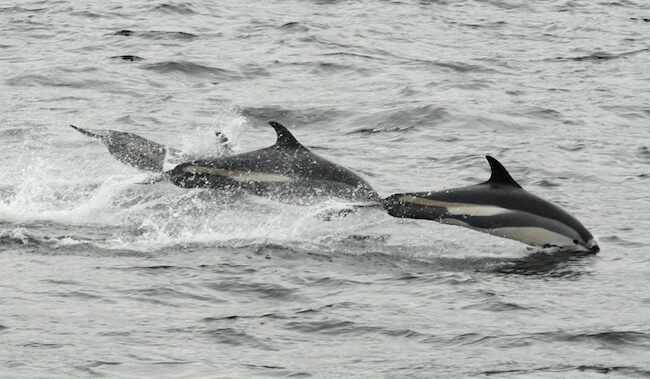July 1, Fjord-du-Saguenay National Park. In the dusty light at the end of the day, light breaths appear for a fraction of a second, followed by backs obscured by the backlight. About twenty belugas are swimming and diving in the bay. Tails rise into the air before slapping back down onto the water surface. Their exhalations break the silence of the bay and the surrounding mountains. A few surface vocalizations as well, which sound like bizarre grunts to my human ears. I go down to the beach and take off my cap as if entering a church. Indeed, many say that there is something almost sacred or even mystical about Baie Sainte-Marguerite. Biologists, on the other hand, note that it plays an important or even vital role for belugas, which gather here to socialize, care for their young, rest and feed. Conservationists have decided to protect this bay from June 21 to September 21 by prohibiting watercraft in order to offer these white whales a peaceful sanctuary in the Saguenay. The two harbour seals swimming there that afternoon must also appreciate these now-quiet waters. I enjoy this sublime show for an hour, my feet in the Sainte-Marguerite River, before heading back
Dolphins of the St. Lawrence
The St. Lawrence is visited by dolphins during the summer. The first reports of dolphins come from Cap Bon-Ami in the Gaspé Peninsula’s Forillon National Park. Other dolphins are seen from the rocks of Essipit on June 28. On July 1, in the Saguenay-St. Lawrence Marine Park, four individuals swim dynamically. Considering that this is the Estuary, they are most likely Atlantic white-sided dolphins. Two other dolphin species frequent the St. Lawrence from time to time: the white-beaked dolphin, similar in size and shape to its white-sided cousin, and the much larger killer whale. Observers occasionally confuse dolphins with another species, the harbour porpoise. How can one tell them apart?
The harbour porpoise is smaller in size. Its fin is triangular, while that of white-sided dolphins is more curved and narrow at the tip. The two species swim differently as well. Porpoises come to the surface in a quick, rounded movement, like a little leap. Dolphins will also give the impression they are rolling over themselves, but with a slightly flatter back. Because a picture is worth a thousand words, here are two videos that show the difference in surface swimming patterns.
Another indication they are dolphins and not porpoises: jumping! Dolphins are skillful and frequent leapers. They have the ability to thrust their entire body out of the water. Porpoises do not have this habit.
Extraordinary diversity
“The Gulf is hot these days!” exclaims an observer from the Gaspé. For the past few days, she has been taking advantage of the presence of dolphins, minke whales and humpbacks, no matter where she is along the coast. Recently settled in the Gaspé village of L’Anse-au-Griffon, one couple is gradually learning to identify different species of whales thanks to the help of locals. On June 27, they tally four fin whales. “It’s like, we didn’t truly believe that we would actually be able to watch whales all day long, all the time, no matter what we are doing. There is so much life!” exclaim the Québec City natives
The presence of whales on the surface provides a glimpse of how rich the St. Lawrence is, but a dive into its depths allows you to discover flora and fauna that are as colourful as they are diverse.
Stars of the Saguenay-St. Lawrence Marine Park
On July 27, a recreational boater encounters three humpback whales near the Prince Shoal Lighthouse. On July 1, the female humpback Tic Tac Toe was spotted again with a calf. Repeated observations of a female with a calf can help confirm kinship in humpback whales without the need for genetic testing.
Another star from the Saguenay-Saguenay-St. Lawrence Marine Park has also been identified: Bp059, a.k.a. “Trou” This female earned her nickname due to a crater-shaped depression in the middle of the bulge on her left side, just behind the blowhole.
Outside the Marine Park, near Port-Cartier, Jacques Gélineau identifies humpback whale H929 with a calf on June 27. The female is teaching her young to breach, who attempts to imitate her. The two animals repeatedly flick their tails on the surface, a behaviour known as “tailslapping”. Following these exercises, the humpbacks release their excrement. The orange colour is a clear indicator of what they have been eating: krill, in this case.
On June 30, Jacques Gélineau heads out to sea once again. He crosses paths with the calf once more, only this time, it’s alone. Is it already fully weaned? Could be, since nursing lasts 5 to 10 months and calving take place in January. The same day, he spots three minke whales, harbour porpoises, two fin whales and, unfortunately, a lot of garbage that he went out of his way to pick up. Refuse in the marine environment causes great harm to marine mammals.







